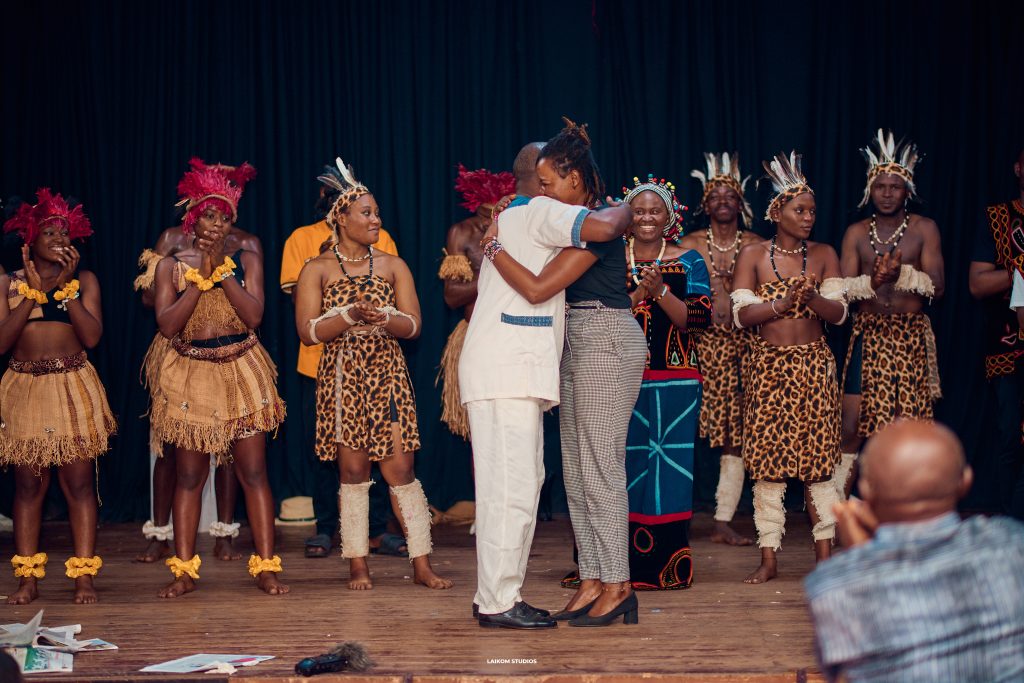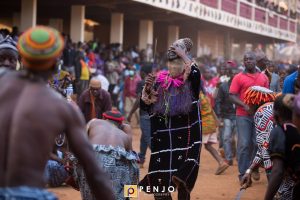My first encounter with the ‘Dead Man’s Chest’ song was in Robert Louis Stevenson’s Treasure Island. The book was one of many my father used to raise me as a lover of literature.
I would read the lines ‘15 men on the dead man’s chest, yo ho ho and a bottle of rum’ and try to create an image in my head. No matter how hard I tried, there lingered the inner feeling I was not doing it right. But the one thing I could have sworn was right, was that the 15 men were white.
Ironically, the first time I ever watched the song sung live, it was by men and women, of skin color, race and roots as myself. It was one of many songs used by the performers as they staged the play ‘Shambles of Haunted Africa, May 25, 2023.

Energy!
Poise!
Surprise!
These are the first three words that shot to mind as the performers took hostage the stage at the Cameroon Cultural Center. Their performance opened with an introspection on the colonial process, what it entailed and the unspeakable levels of cruelty it spelt out. Taking turns, the characters produced a tear-jerking delivery, a reminder that we as Africans are still under the shackles.
They went on to present the bone of contention – demanding attention from museums ignoring demands for stolen African heritages. It was at this point where the characters had their first change to display their versatility, quickly switching roles, costumes and even diction, to present the infamous 1884 Berlin conference. Their vivid manifestation of this conference’s adverse effects on even the most basic fibre of social life, only helped build their case for restitution.

In yet another undeclared segment, the playwright, Dr Tafor Ateh took what appeared to be a complicated story, pieced, tore it further apart and then reconstructed it, producing a simple rendition of the restitution initiative. Give to Africa what you stole from it.
The play quickly narrowed down to the Nso resistances to foreign rule and the violent and cunning methods used to suppress them and erase any specs of freewill. Like was the case throughout most of the piece, the intense use of song to paint moments, was perhaps the play’s biggest strength. Song has an element to depict emotion, and that, it did.
From songs of war for resistance to dirges for the sad inhumane and unspeakable moments, and the ‘dead man’s chest’ song for the post Berlin conference frolicking – every sound moment was sublime, telling. Also conspicuous was the use of rap, a genre frequently used for protest and conscious awakening.

Grey area: The lead lady character (Fomum Jenny Alia) played a crucial role in bringing new perspectives and energy to the story. She represented the intelligence and resilience of the Nso (African) woman, qualities that also characterized Ngonnso, the founder of the Nso dynasty. She often expressed her views with wit and humour, but this also made her appear nagging and troublesome at times. It is unclear whether this was a deliberate choice by the playwright or a side effect of her role in the overall narrative.
The play also overlooked the importance of spirituality and spiritual leaders in the history of the Nso people. The appearance of the Fon in the later stages of the play was predictable, but it did absolve the playwright/producer of the duty to address the role of the church in the colonization process and in undermining the value of artefacts and heritages.

…
Shambles of Africa conveniently fits on the same page with Eystein Young’s allegory, The Planter’s Plantation, released in 2022 The movie tells the story of a plantation transferred to Africans after the departure of the colonial masters.
A blend of love, trust, conflict and jealousy, we are treated to a sour end through the discovery that the colonialists still run the facility through local stooges, remote controlled in the most ridiculous of ways.
Both works tell the colonization story from different entry points, but are similar as they acknowledge the fact that in the African discourse, the car has changed but the owner has not. The one pulling the strings has been relegated to the background, but has not let go of the reins of control.

Eystein tells the story as it is, letting the audience think for themselves and decide what the next move in the decolonisation discourse should be. Adding salt to The Planter’s Plantation-type ending narrative however, Tafor’s play proffers a way out of the quagmire. It brings with it, the need to restitute or at least, attempt to restitute the most possible from what was carted away as well as how.
To borrow from biblical parlance, one would say Eystein plants the seed and Dr Tafor waters it… you know who can make it grow.
To achieve its intended outcome, Dr Tafor’s play the play first depicts a number of methods that will be counterproductive including outright war or attempting to steal the heritages from the museums. It then paints a picture of an African court as arbitrator, compelling colonial nations to accept fault, return the heritages, and pay reparation costs.

In the post-play conversation, this same solution was dwelled upon, as performers, the playwright and producer unpacked the sequence and its message. Activist, Sylvie Njobati who doubled as producer for the play noted that there remains a series of nonviolent ways to bring them to commit, including petitions, community advocacy, and protests.
To Dr Dr Tafor Ateh, the story told itself through the colonialists, and all he had to do was lift the audience’s heads to the direction of the screen: “The words that you heard, a lot of the words, 70% are true facts that we picked out and the only thing I did was to try to bring in 30 to 40% of some drama to make it interesting to watch…”
Did you enjoy this? Check out more









